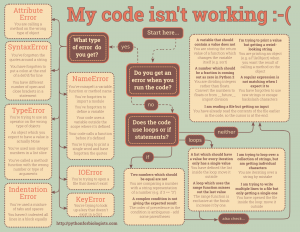How to ask for help: Difference between revisions
Mr. MacKenty (talk | contribs) |
Mr. MacKenty (talk | contribs) No edit summary |
||
| Line 49: | Line 49: | ||
== Debug your code == | == Debug your code == | ||
There are different techniques you can use when debugging your code. Most of them can be distilled to a few simple techniques: | |||
# Look for error or warnings in your IDE | |||
# Read error logs | |||
# Walk away for a few minutes. | |||
# Explain the problem to a friend | |||
[[ | * [[File:PHP problem solving checklist - Google Docs.pdf | Click here for a PHP debugging checklist]] | ||
I encourage students to open a new tab in their terminal window. The command below will create a running list of errors. To escape from the output, push the key combination control-C. | I encourage students to open a new tab in their terminal window. The command below will create a running list of errors. To escape from the output, push the key combination control-C. | ||
| Line 60: | Line 62: | ||
tail -f /var/log/php/error.log | tail -f /var/log/php/error.log | ||
== Click the image to learn about common mistakes == | == Click the image to learn about common mistakes == | ||
[[File:Problem.png|center|thumb|caption|You must learn to solve problems.]] | [[File:Problem.png|center|thumb|caption|You must learn to solve problems.]] | ||
== References == | == References == | ||
Revision as of 13:07, 12 July 2017
Having problems is normal. If you do not learn how to solve your own problems, life will be difficult for you.
Step One: Why can't you write this program?[edit]
When you first realize you have a problem, follow these steps:
With gratitude to and permission from Stephen Hughes (Coe College) and Philip East (University of Northern Iowa)[1]
| Type of problem | What you need to do to solve it |
|---|---|
| I don't understand the problem | #Requirements Gathering |
| I can’t describe how to get a solution | #Algorithmic thinking; problem decomposition |
| I don’t know all the details | #Real world problems require research |
| I can solve it by hand, but I don’t know how to code it. | #New Language Features |
| My code isn't working the way it should | #Debug your code |
Requirements Gathering[edit]
Do you understand EVERY. SINGLE. WORD. in the problem? In this case the student needs to: re-examine the problem statement identifying specific problem requirements; play with the problem—draw pictures of interaction, imagine inputs & outputs, ...; seek clarification from the originator of the problem, etc.[2]
Algorithmic thinking; problem decomposition[edit]
If you don't know how to get to a solution, break the problem down into smaller parts.
A common obstacle novice programmers face arises from difficulty with problem representation—making the problem more concrete in their minds. They are not familiar with thinking abstractly in terms of variables and operations on them. The action in this case is to specify the desired outcome and begin problem decomposition from that point. Produce questions that indicate intermediate outcomes desired or information needed. Identify data needed to produce the outcomes and where that data must come from; necessary manipulations of the data; tasks that may need to be repeated or occur depending on some aspect of the problem data; etc.[3]
- Create a diagram of the problem
- Draw a picture of the problem
- Explain the problem to a rubber duck (really)
- Forget about a computer; how would you solve this with a pencil and paper?
- Think out loud
- Explain the problem to a friend
Real world problems require research[edit]
In this case domain knowledge is lacking. Additional research on the task is required. It may be as simple as looking up a formula; finding rules for a game; etc.[4]
For example, if you are asked to solve a problem by writing a program which converts celsius to fahrenheit you might have not memorized the formula.
New Language Features[edit]
A different kind of research is needed here. Students can look up information in their text books or online about how some task can be accomplished in the programming language being used. Alternatively, they may need to consider how the problem can be represented using numbers and string or collections of them. Or, they might be encouraged to ask the teacher![5]
Debug your code[edit]
There are different techniques you can use when debugging your code. Most of them can be distilled to a few simple techniques:
- Look for error or warnings in your IDE
- Read error logs
- Walk away for a few minutes.
- Explain the problem to a friend
I encourage students to open a new tab in their terminal window. The command below will create a running list of errors. To escape from the output, push the key combination control-C.
tail -f /var/log/php/error.log
